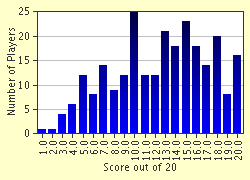Quiz Answer Key and Fun Facts
1. "The Magic Flute" premiered in Vienna on September 30, 1791, three months before the composer's death. Mozart wrote the music, but who wrote the libretto?
2. What is The Magic Flute, exactly?
3. Mozart wrote The Magic Flute in only 6 months. This was even more impressive when one considers that he also wrote another opera at the same time - a serious, Italian one to celebrate the coronation of Leopold II. Which one was this?
4. Part of the myth surrounding "The Magic Flute" is its association with a secret society. Which one?
5. All the characters in "The Magic Flute" have some symbolic significance - some easy to spot, some not. The Queen of the Night, in particular, has been the object of a lot of speculation. She's certainly evil, but who or what is she supposed to represent?
6. Monostatos, the second-string villain, is a controversial character for modern audiences. Why?
7. Now it's time for the story. The curtain rises on the handsome Prince Tamino, who is desperately calling for help. Why is he so frightened?
8. When Tamino comes to and realizes he's been rescued, who takes the credit?
9. The Queen of the Night arrives and plays on Tamino's ready sympathies. She tells him that Sarastro, an evil wizard and coincidentally her ex, has kidnapped their daughter. If Tamino can get the girl back, she's his. Tamino is pretty impressed with the daughter's portrait. He falls in love instantly and sings...
10. The three ladies get Tamino and Papageno ready for their quest. They give them two gifts that will help them. Tamino, of course, gets the magic flute. What's Papageno's present?
11. When they reach the Temple of Wisdom, Tamino and Papageno split up. Papageno stumbles upon Monostatos trying to rape Pamina and saves her. Tamino meets the speaker, who quickly convinces him that the queen has lied to him about Sarastro. How? The speaker tells Tamino...
12. 'Das klinget so herrlich, das klinget so schoen! Nie hab ich so etwas gehoert und geseh'n...' We've never heard anything so lovely! We've just got to dance! Who is enchanted here?
13. Tamino and Papageno begin their intitation into the Temple. What must they take a vow of?
14. It's night. Pamina is lying asleep on a couch. Monostatos spots her. Now's his chance! He gets closer...closer... Kaboom! 'Die Hoelle Rache kocht in meinem Herzen, Tod und Verzweiflung flammet um mich her!' Curses! Foiled again! Whose great big revenge aria has broken up the tender scene?
15. Poor Pamina. She believes that Tamino has rejected her and she's thinking of suicide. Just at the point of plunging in the knife, someone stops her. Who?
16. Pamina approaches a rocky cave guarded by two men in armour. They sing a short chorale of the dangers Tamino must face. If you always thought this didn't sound much like Mozart, you're right. He didn't write it. Who (probably) did?
17. Tamino is about to face the final tests of fire and water. No way he's going alone, says Pamina, and insists on going too. It is at this point that Tamino realizes for sure that she's a worthy mate and not like other women at all. This motif of the possiblity of equal and happy union, however, was raised earlier in the opera in a simpler, more homely way. What piece celebrated marriage?
18. 'Gute Nacht, du falsche Welt!' Tamino and Pamina are fine, but Papageno decides that life without a wife is not worth living and he's never going to get that wife he's been promised. It's suicide for him too. He decides to give the world one last chance, though, and does something almost unknown elsewhere in standard opera. What?
19. It's not quite over yet. The Queen of the Night has promised Pamina to Monostatos if he helps her, and her ladies destroy Sarastro and the temple. They rush in, only to be instantly destroyed by...what?
20. In 1975 a film was made of The Magic Flute by a director with a rare ability to see the world through the eyes of a child. His fascination for 18th and 19th-century stagecraft also appears to effect, as it was filmed in the 18th-century theatre at Drottningholm Castle in Stockholm. Who is this director?
Source: Author
dobrov
This quiz was reviewed by FunTrivia editor
bullymom before going online.
Any errors found in FunTrivia content are routinely corrected through our feedback system.


